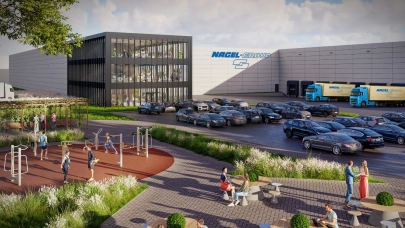
The total volume of modern office space in Prague has increased to almost 4 million sqm at the end of 2024 with 72,800 sqm completed in the entire year of 2024. However, the situation is going to be even worse in 2025 and 2026, according to the Trend Report 2025 study published by the Association for Real Estate Development.
The survey shows that only 29% of experts expect a slight increase in new space in the office real estate market in 2025–2026, which is the lowest recorded value since 2020. And also the least of all sectors of the real estate market. In contrast, a record 68% of respondents expect stagnation with a minimum of new space. The remaining 3% of respondents cannot predict further developments.
In 2025, just under 25,000 sqm should be completed, which will be the lowest recorded increase in the Prague market in history. The ten-year average exceeds 120,000 sqm. Projects to be completed in 2025 include PernerKa in Karlín, the first phase of E-Factory in Pragovka, and the reconstruction of smaller buildings NR7 on Náměstí Republiky and VN62 on Wenceslas Square. In 2026, only approximately 50,000 sqm are expected.
The significant decrease in the number of completed office spaces is due to a confluence of several factors. “The main one was the availability of financing – in recent years, the requirements of not only clients but also banks for the quality and sustainability of buildings have been growing rapidly. Not all interested parties today will be able to obtain the necessary financing or the rate they would have imagined,” explains David Musil, member of the ARTN BoD and CMD at Penta Real Estate for the Czech Republic.
Another factor is the geopolitical and economic situation, which will only become fully apparent after a few years. "Buildings that should have been completed this year would have started to be built in 2022. Then the war broke out in Ukraine, world markets were fluctuating, the prices of construction materials were soaring, and the Czech Republic was struggling with unprecedentedly high inflation. Together with almost zero demand from large corporations, which logically would rather wait for future developments than rush into costly expansion or relocation, it was a rather unfavourable mix," describes Jiří Ochetz, Member of BoD at J&T Real Estate CZ.
While a minimum of new projects are being completed, demand gradually returned during the last year and this year and is also reflected in the pressure on rent growth. "We currently record the demand value of new buildings, the so-called primary market, in established quality non-central locations at the level of €21-25 per sqm per month," says Eduard Forejt, Sales Director at Passerinvest Group. According to Musil from Penta Real Estate, average rates in modern buildings in central locations rise above €30.
A survey for the Trend Report shows that the attractiveness of office properties for investors has been gradually increasing in recent years. While in 2021 only 12% of respondents felt an attractive or growing interest among investors, in 2022–2024 it was between 13 and 17%, and in 2025, 27% of respondents already perceived a positive increase.
However, as Ochetz from J&T Real Estate CZ adds, the current revenues from the development of office buildings are not dizzying at all. “It is more like waiting to see what the gap will do to the market, which will logically arise from the low number of completed new spaces. The goal is then to build for an anchor tenant who will occupy the entire or almost the entire building. But that has always been true, it is just a little more difficult now,” he explains.
According to Forejt, in terms of occupancy, it is necessary to look not only at Europe but also at the USA, where trends are often transmitted to our region through branches of global companies. “At the end of last year, the American Flex Index recorded changes in the behaviour of companies, when many companies with fully flexible use of offices, i.e. without controlled presence, decreased. The winner, from the changes in the behaviour of American companies, is the structured hybrid, i.e. a system with fixed days in the office, with a representation of 43%,” adds Forejt.
Increasing demands on office buildings are not only imposed by the tightening ESG regulations, but also by the requirements of primarily corporate tenants and financing banks, which are largely unwilling to finance buildings that do not meet the demanding requirements for fulfilling ESG criteria. By 2030, new buildings will have to comply with the requirements for zero energy consumption.



